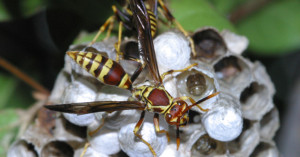Paper wasps, in the genus Polistes, are among the most common garden insects in late summer in Texas. Nearly everyone at some time has seen their umbrella-like nests dangling from tree branches or the eaves of buildings. While I’ve seen and watched many of these nests over the years, I have to admit I’ve never heard anything unusual. But, according to a new paper published in Biology and Nature, for years people have noted a distinct drumming sound coming from some paper wasp nests.
Originally thought to be a form of communication, a new paper reported in e! Science News, proposes a different explanation. In a neat study, Robert Jeanne, professor emeritus of entomology at the University of Wisconsin, and post-doctoral researcher Sainath Suryanarayanan, show that “antennal drumming” by queen and worker wasps appears to have an unusual function. Paper wasp babies exposed to constant drum beats from their caregivers’ antennae causes them to develop into skinny worker wasps. Larvae not exposed to this “insect rock music” get fatter and are more likely to develop into the king and queen wasps capable of surviving the extended cold of winter.
The way our researchers discovered this link is pretty cool, and illustrates how elegant the research process can be. In previous field studies, Jeane and Suryanarayanan observed that antennal drumming is very common early in the summer, when colonies produce lots of worker wasps to build the nest and take care of an expanding brood. The behavior drops off, however, to nearly zero by late summer. This is when the reproductive wasps — males and future queens — are being reared.
Working together with USDA Forest Products engineer, John Hermanson, the two entomologists created an electrical device to simulate antennal drumming on a nest. When late season nests (that would normally produce only kings and queens) were drummed, the emerging adults resembled worker wasps, with much lower fat stores. The researchers concluded that the wasps use the vibrations from antenna drumming to drive developing larvae toward one caste or the other.
This process differs from honey bee queens, which disperse special chemical perfumes (pheromones) to direct the castes of offspring.
All this makes me wonder what the effect constant exposure to the beat of rock music might have on humans? While the connection there is doubtless slim (no pun intended), the research has given me a greater appreciation for the paper wasp itself. The next time I’m close to a paper wasp nest I’ll listen more closely… after I unplug my iPod.

